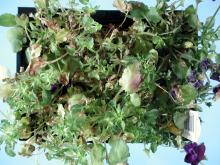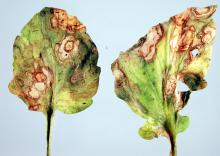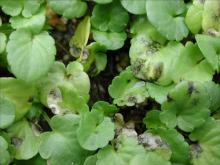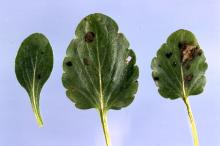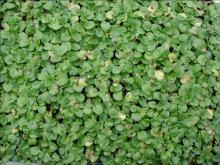Cause Several fungal leaf spots have been reported from the Pacific Northwest including Ramularia agrestis, R. lactea, and Cercospora violae. Other fungi such as Alternaria sp. and Colletotrichum sp. (anthracnose) are also common leaf spot problems. Leaf spots are favored by warm, humid conditions especially later in the growing season during fall. Low nutrition levels also can favor these leaf spots. Cercospora can be seedborne.
Many abiotic leaf spots are sent into the OSU Plant Clinic, which are difficult to distinguish from biotic leaf spots. These abiotic spots will not be controlled with pesticides so a good diagnosis is important. A few bacteria and viruses can also cause leaf spots but are not as common.
Symptoms Cercospora violae produces large, fast spreading purple lesions on lower, older leaves that dry and turn necrotic. Spore production may make tan necrotic centers of the spots look blackened. Spots are irregular in both size and shape and do not have a sharp, rounded outline. The lower affected leaves may turn yellow and drop. May be easily confused with other leaf spots.
Alternaria sp. produces small circular spots with tan centers, surrounded by a purple-red halo. Can occur on various aged leaves.
Anthracnose is first seen as brown to tan spots appearing on the tip or edge of the leaf. The entire leaf may become blighted later. A black margin separates healthy tissue from infected tissue. Small, whisker-like black fungal structures (acervuli) containing the spores can be seen in the spots. Spots generally are on the lower foliage first. Petioles and stems may also be infected.
Cultural control Regular scouting will aid overall control efforts.
- Rotate plantings in the garden.
- Remove dead and dying foliage in and around the plants.
- Avoid irrigation that lets plants remain wet a long time. Reduce humidity by using fans and ventilating the greenhouse after watering.
- Maintain high light levels and good air movement around the foliage.
- Maintain adequate fertility.
- Use new or sterile pots and trays. Avoid reusing pots and trays. If reusing, thoroughly remove organic matter and soil, then wash with a disinfectant such as a 10% bleach solution or treat them with aerated steam at 122°F for 30 min.
Chemical control If needed, use before symptoms are expected to develop. Focus on cultural controls. Rotate fungicides with different modes of action to prevent the development of resistant organisms. Limit the use of any one group during crop production.
- Affirm WDG at 0.25 to 0.5 lb/100 gal water. Group 19 fungicide. 4-hr reentry.
- Armada 50 WDG at 3 to 9 oz/100 gal water. Do not use a silicone-based surfactant. Not for nursery or greenhouse use. Group 3 + 11 fungicide. 12-hr reentry.
- Avelyo at 3 to 5 fl oz/100 gal water. Group 3 fungicide. 12-hr reentry.
- Bonide Fung-onil Multi-purpose Fungicide at 2.25 teaspoons/gal water. Group M5 fungicide. H
- Broadform at 4 to 8 fl oz/100 gal water. Group 7 + 11 fungicide. 12-hr reentry.
- Compass 50 WDG at 1 to 2 oz/100 gal water. Do not use organosilicate additives. Group 11 fungicide. 12-hr reentry.
- Daconil Weather Stik at 1.38 pints/100 gal water. Group M5 fungicide. 12-hr reentry.
- Disarm 480 SC at 1 to 4 fl oz/100 gal water. Group 11 fungicide. 12-hr reentry.
- Eagle 20 EW at 6 to 12 fl oz/100 gal water. Group 3 fungicide. 24-hr reentry.
- Heritage at 1 to 2 oz/100 gal water plus a non-silicone-based wetter sticker. Group 11 fungicide. 4-hr reentry.
- Insignia SC at 3 to 6 fl oz/100 gal water. Do not use with organosilicate-based adjuvants. Use preventively only. Group 11 fungicide. 12-hr reentry.
- KleenGrow at 12 to 25 fl oz/100 gal water. 48-hr reentry.
- Mancozeb-based products. Group M3 fungicides. 24-hr reentry.
- Fore 80 WP at 1.5 lb/100 gal water plus a spreader-sticker.
- Protect DF at 1 to 2 lb/100 gal water plus 2 to 4 oz spreader-sticker.
- Medallion WDG at 1 to 2 oz/100 gal water is labeled for several leaf-spotting organisms. Using with oils or adjuvants may damage plant. Group 12 fungicide. 12-hr reentry.
- Monterey Liqui-Cop at 3 Tbsp/gal water. H
- Myclobutanil 20 EW T&O at 6 to 12 fl oz/100 gal water plus spreading agent. May observe a PGR effect. Group 3 fungicide. 24-hr reentry.
- Nu-Cop 50 DF at 1 lb/100 gal water. May discolor blooms. Group M1 fungicide. 48-hr reentry general or 24-hr reentry for greenhouse.
- Orkestra at 4 to 10 fl oz/100 gal water. Group 7 + 11 fungicide. 12-hr reentry.
- Pageant at 8 to 12 oz/100 gal water. Do not use with organosilicone-based adjuvant. Group 7 + 11 fungicide. 12-hr reentry.
- Palladium at 4 to 6 oz/100 gal water. Avoid excessive runoff to small plants, which may result in stunting and/or chlorosis. Group 9 + 12 fungicide. 12-hr reentry.
- Phyton 27 at 1.3 to 2 oz/10 gal water is registered for Cercospora. Group M1 fungicide. 48-hr reentry.
- Postiva at 10 to 28 fl oz/100 gal water. Group 3 + 7 fungicide. 12-hr reentry.
- Spectro 90 WDG at 1 to 2 lb/100 gal water. Group 1 + M5 fungicide. 12-hr reentry.
- Spirato GHN at 2 to 4 fl oz/100 gal water. Use with oils or adjuvants may cause plant damage. Group 12 fungicide. 12-hr reentry.
- Terraguard SC at 4 to 8 fl oz/100 gal water. Group 3 fungicide. 12-hr reentry.
- Thiophanate-methyl-based products. Group 1 fungicides. 12-hr reentry.
- Cleary's 3336 EG at 12 to 16 oz/100 gal water.
- OHP 6672 4.5 F at 7.5 to 20 fl oz/100 gal water.
Biological control
- Cease or Rhapsody (Bacillus subtilis strain QST 713) at 2 to 8 quarts/100 gal water. Active ingredient is a small protein. Was effective against Cercospora leaf spot in one trial in California. 4-hr reentry. O
Note: Although Trinity TR is registered it is not recommended due to phytotoxicity issues.
Reference Hagan, A.K. 2003. Chemical control of Cercospora leaf spot of pansy, 2002. Fungicide and Nematicide Tests 58: OT041.

